Applying Ethical Theory to Australian Driverless Trucks Scenario
VerifiedAdded on 2023/06/12
|9
|2465
|130
AI Summary
This assignment applies four ethical theories to the scenario of driverless trucks in Australia, analyzing the potential consequences and benefits of the technology. The theories applied are utilitarianism, deontology, virtue theory, and contract theory. The report discusses the impact of the technology on the Australian economy, the transportation sector, and the communities linked to it. The report concludes that the implementation of driverless trucks in Australia is ethically immoral from a utilitarian and virtue theory perspective, but ethically correct from a deontological and contract theory perspective.
Contribute Materials
Your contribution can guide someone’s learning journey. Share your
documents today.
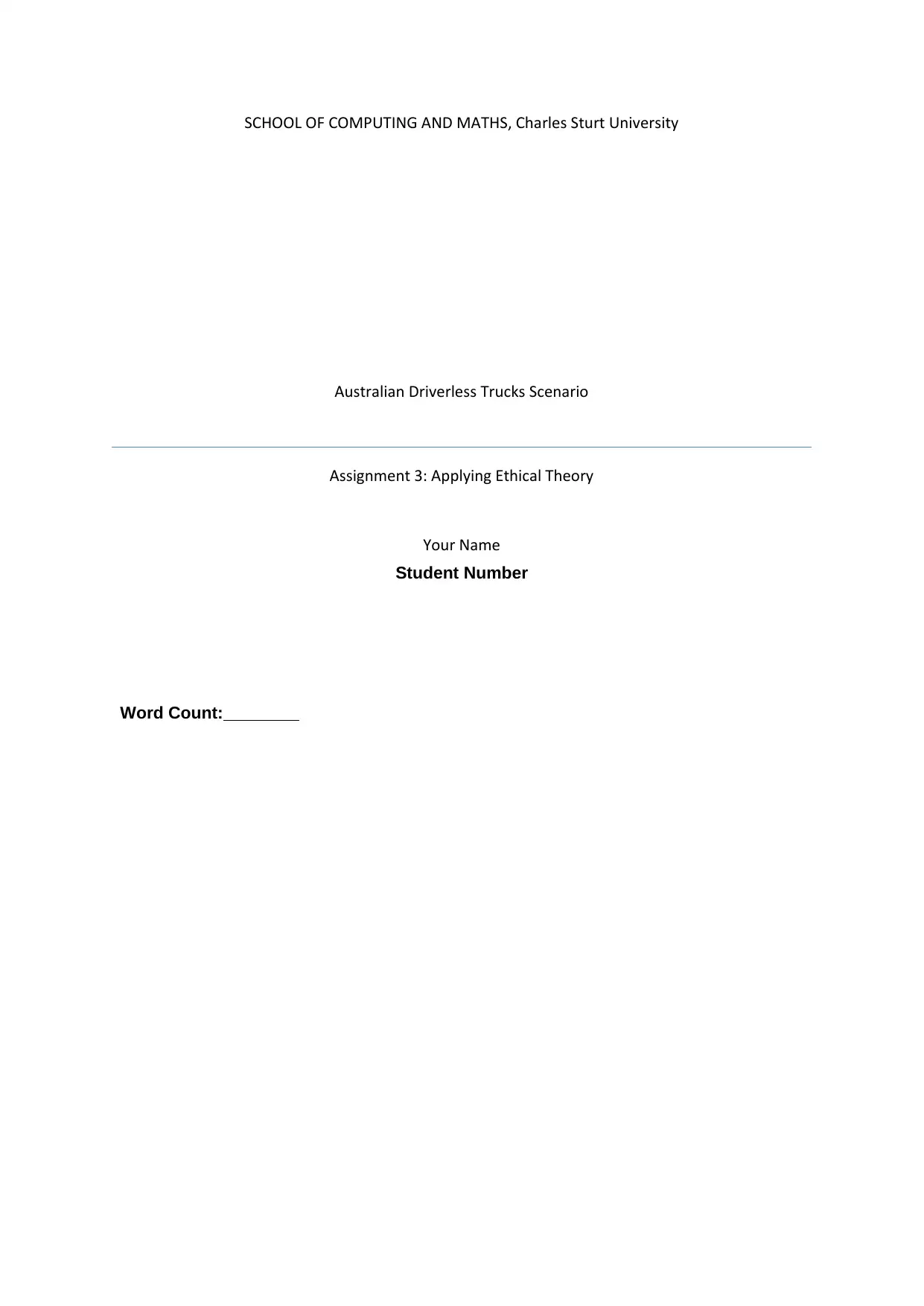
SCHOOL OF COMPUTING AND MATHS, Charles Sturt University
Australian Driverless Trucks Scenario
Assignment 3: Applying Ethical Theory
Your Name
Student Number
Word Count:
Australian Driverless Trucks Scenario
Assignment 3: Applying Ethical Theory
Your Name
Student Number
Word Count:
Secure Best Marks with AI Grader
Need help grading? Try our AI Grader for instant feedback on your assignments.
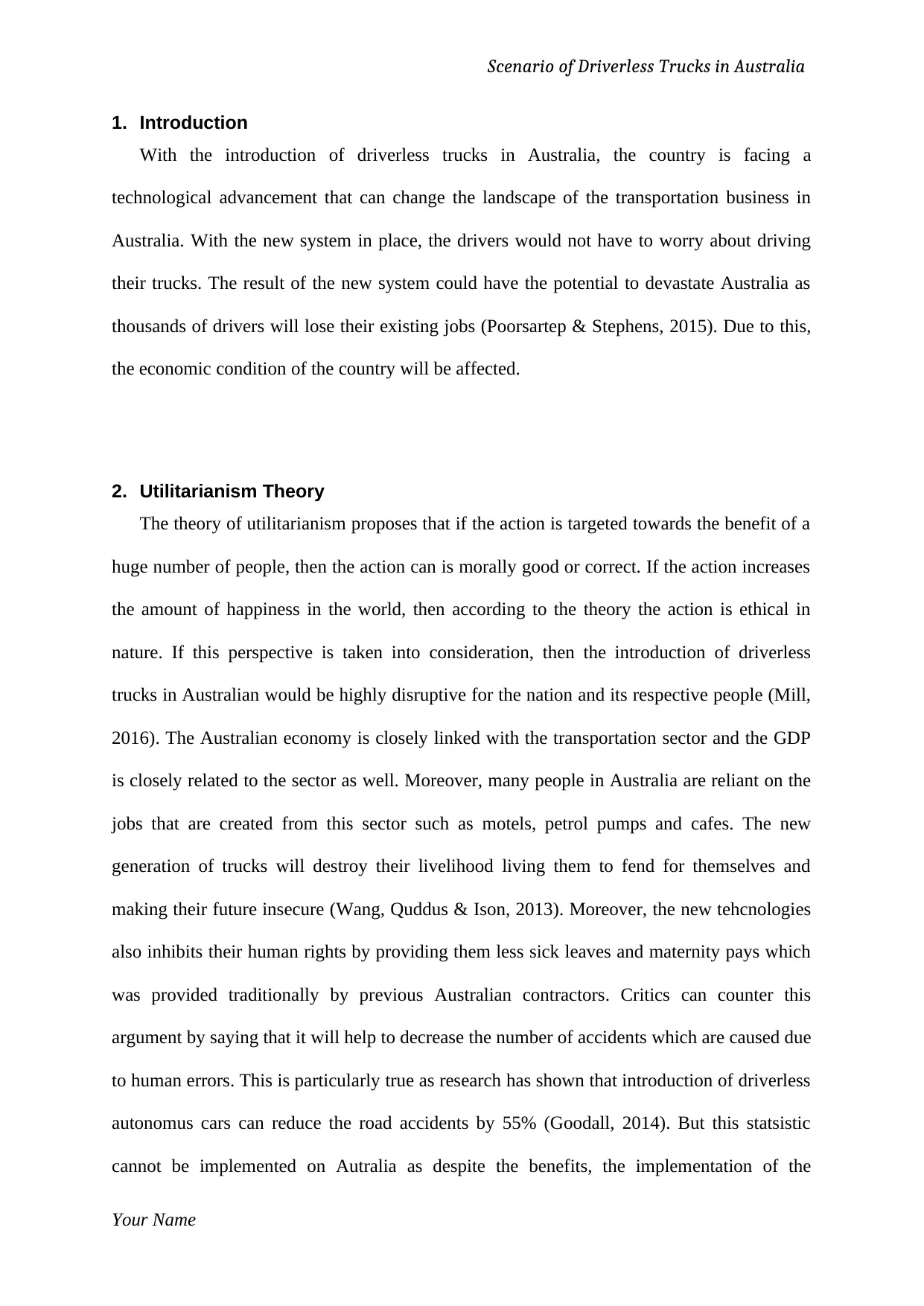
Scenario of Driverless Trucks in Australia
1. Introduction
With the introduction of driverless trucks in Australia, the country is facing a
technological advancement that can change the landscape of the transportation business in
Australia. With the new system in place, the drivers would not have to worry about driving
their trucks. The result of the new system could have the potential to devastate Australia as
thousands of drivers will lose their existing jobs (Poorsartep & Stephens, 2015). Due to this,
the economic condition of the country will be affected.
2. Utilitarianism Theory
The theory of utilitarianism proposes that if the action is targeted towards the benefit of a
huge number of people, then the action can is morally good or correct. If the action increases
the amount of happiness in the world, then according to the theory the action is ethical in
nature. If this perspective is taken into consideration, then the introduction of driverless
trucks in Australian would be highly disruptive for the nation and its respective people (Mill,
2016). The Australian economy is closely linked with the transportation sector and the GDP
is closely related to the sector as well. Moreover, many people in Australia are reliant on the
jobs that are created from this sector such as motels, petrol pumps and cafes. The new
generation of trucks will destroy their livelihood living them to fend for themselves and
making their future insecure (Wang, Quddus & Ison, 2013). Moreover, the new tehcnologies
also inhibits their human rights by providing them less sick leaves and maternity pays which
was provided traditionally by previous Australian contractors. Critics can counter this
argument by saying that it will help to decrease the number of accidents which are caused due
to human errors. This is particularly true as research has shown that introduction of driverless
autonomus cars can reduce the road accidents by 55% (Goodall, 2014). But this statsistic
cannot be implemented on Autralia as despite the benefits, the implementation of the
Your Name
1. Introduction
With the introduction of driverless trucks in Australia, the country is facing a
technological advancement that can change the landscape of the transportation business in
Australia. With the new system in place, the drivers would not have to worry about driving
their trucks. The result of the new system could have the potential to devastate Australia as
thousands of drivers will lose their existing jobs (Poorsartep & Stephens, 2015). Due to this,
the economic condition of the country will be affected.
2. Utilitarianism Theory
The theory of utilitarianism proposes that if the action is targeted towards the benefit of a
huge number of people, then the action can is morally good or correct. If the action increases
the amount of happiness in the world, then according to the theory the action is ethical in
nature. If this perspective is taken into consideration, then the introduction of driverless
trucks in Australian would be highly disruptive for the nation and its respective people (Mill,
2016). The Australian economy is closely linked with the transportation sector and the GDP
is closely related to the sector as well. Moreover, many people in Australia are reliant on the
jobs that are created from this sector such as motels, petrol pumps and cafes. The new
generation of trucks will destroy their livelihood living them to fend for themselves and
making their future insecure (Wang, Quddus & Ison, 2013). Moreover, the new tehcnologies
also inhibits their human rights by providing them less sick leaves and maternity pays which
was provided traditionally by previous Australian contractors. Critics can counter this
argument by saying that it will help to decrease the number of accidents which are caused due
to human errors. This is particularly true as research has shown that introduction of driverless
autonomus cars can reduce the road accidents by 55% (Goodall, 2014). But this statsistic
cannot be implemented on Autralia as despite the benefits, the implementation of the
Your Name
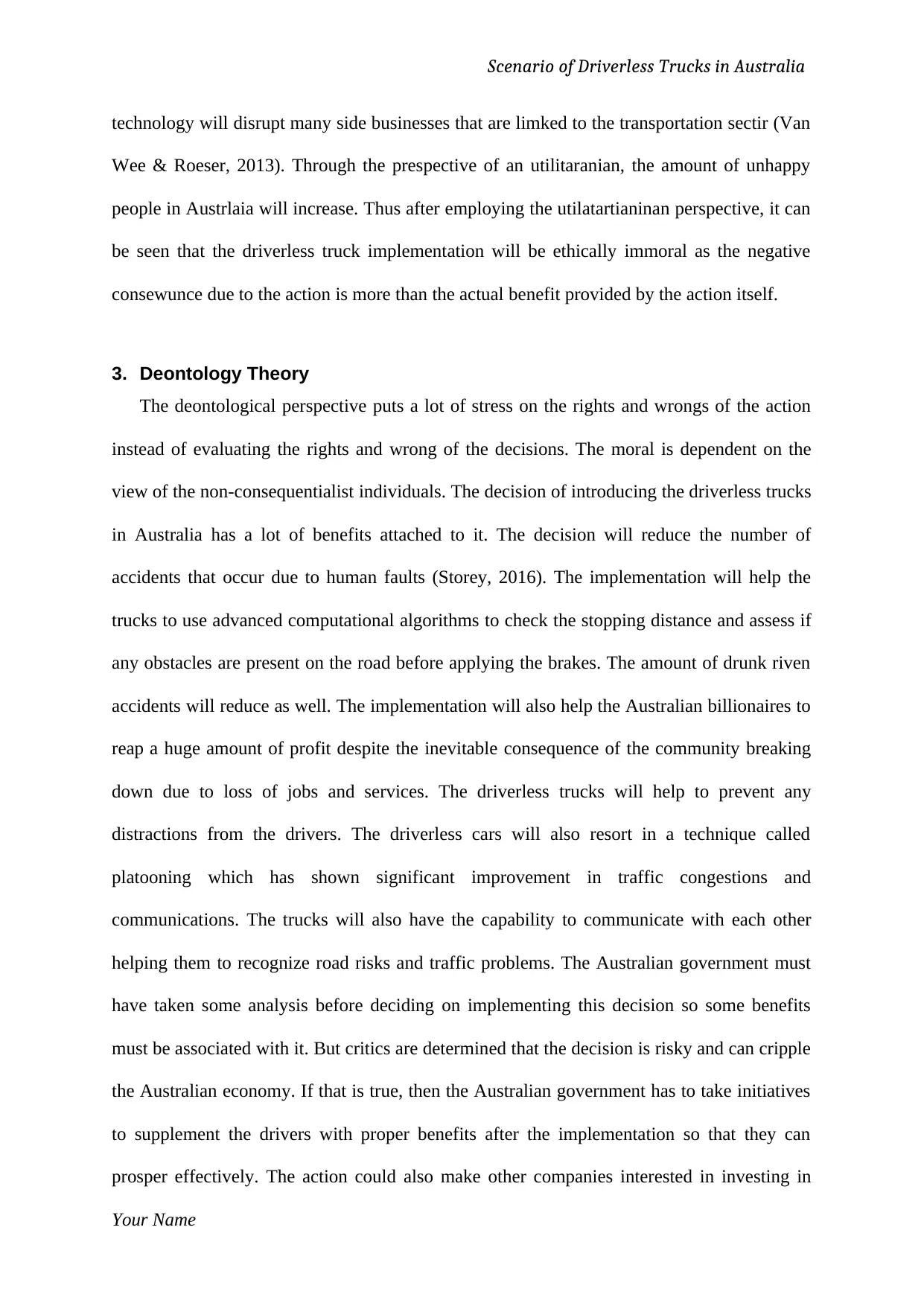
Scenario of Driverless Trucks in Australia
technology will disrupt many side businesses that are limked to the transportation sectir (Van
Wee & Roeser, 2013). Through the prespective of an utilitaranian, the amount of unhappy
people in Austrlaia will increase. Thus after employing the utilatartianinan perspective, it can
be seen that the driverless truck implementation will be ethically immoral as the negative
consewunce due to the action is more than the actual benefit provided by the action itself.
3. Deontology Theory
The deontological perspective puts a lot of stress on the rights and wrongs of the action
instead of evaluating the rights and wrong of the decisions. The moral is dependent on the
view of the non-consequentialist individuals. The decision of introducing the driverless trucks
in Australia has a lot of benefits attached to it. The decision will reduce the number of
accidents that occur due to human faults (Storey, 2016). The implementation will help the
trucks to use advanced computational algorithms to check the stopping distance and assess if
any obstacles are present on the road before applying the brakes. The amount of drunk riven
accidents will reduce as well. The implementation will also help the Australian billionaires to
reap a huge amount of profit despite the inevitable consequence of the community breaking
down due to loss of jobs and services. The driverless trucks will help to prevent any
distractions from the drivers. The driverless cars will also resort in a technique called
platooning which has shown significant improvement in traffic congestions and
communications. The trucks will also have the capability to communicate with each other
helping them to recognize road risks and traffic problems. The Australian government must
have taken some analysis before deciding on implementing this decision so some benefits
must be associated with it. But critics are determined that the decision is risky and can cripple
the Australian economy. If that is true, then the Australian government has to take initiatives
to supplement the drivers with proper benefits after the implementation so that they can
prosper effectively. The action could also make other companies interested in investing in
Your Name
technology will disrupt many side businesses that are limked to the transportation sectir (Van
Wee & Roeser, 2013). Through the prespective of an utilitaranian, the amount of unhappy
people in Austrlaia will increase. Thus after employing the utilatartianinan perspective, it can
be seen that the driverless truck implementation will be ethically immoral as the negative
consewunce due to the action is more than the actual benefit provided by the action itself.
3. Deontology Theory
The deontological perspective puts a lot of stress on the rights and wrongs of the action
instead of evaluating the rights and wrong of the decisions. The moral is dependent on the
view of the non-consequentialist individuals. The decision of introducing the driverless trucks
in Australia has a lot of benefits attached to it. The decision will reduce the number of
accidents that occur due to human faults (Storey, 2016). The implementation will help the
trucks to use advanced computational algorithms to check the stopping distance and assess if
any obstacles are present on the road before applying the brakes. The amount of drunk riven
accidents will reduce as well. The implementation will also help the Australian billionaires to
reap a huge amount of profit despite the inevitable consequence of the community breaking
down due to loss of jobs and services. The driverless trucks will help to prevent any
distractions from the drivers. The driverless cars will also resort in a technique called
platooning which has shown significant improvement in traffic congestions and
communications. The trucks will also have the capability to communicate with each other
helping them to recognize road risks and traffic problems. The Australian government must
have taken some analysis before deciding on implementing this decision so some benefits
must be associated with it. But critics are determined that the decision is risky and can cripple
the Australian economy. If that is true, then the Australian government has to take initiatives
to supplement the drivers with proper benefits after the implementation so that they can
prosper effectively. The action could also make other companies interested in investing in
Your Name
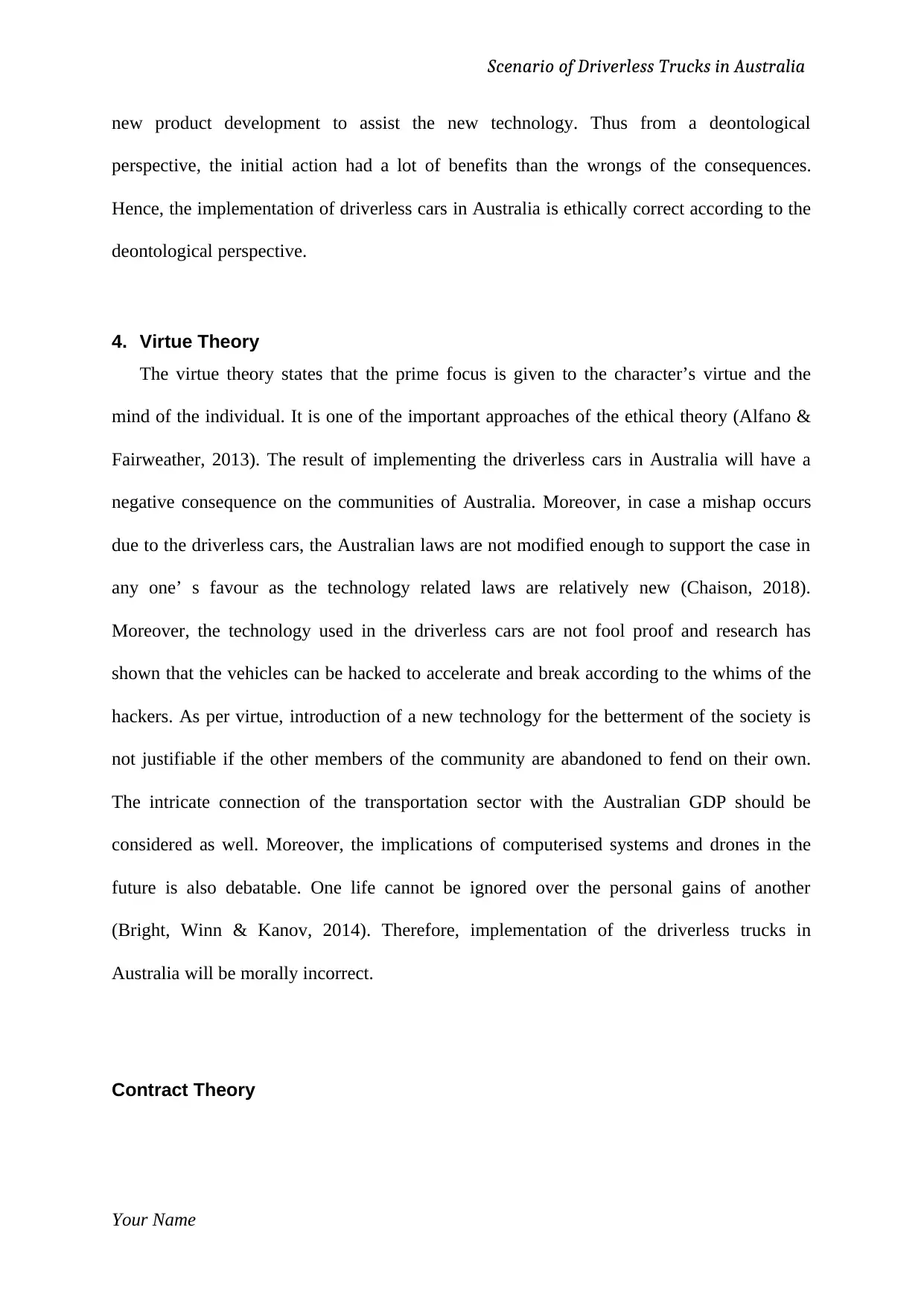
Scenario of Driverless Trucks in Australia
new product development to assist the new technology. Thus from a deontological
perspective, the initial action had a lot of benefits than the wrongs of the consequences.
Hence, the implementation of driverless cars in Australia is ethically correct according to the
deontological perspective.
4. Virtue Theory
The virtue theory states that the prime focus is given to the character’s virtue and the
mind of the individual. It is one of the important approaches of the ethical theory (Alfano &
Fairweather, 2013). The result of implementing the driverless cars in Australia will have a
negative consequence on the communities of Australia. Moreover, in case a mishap occurs
due to the driverless cars, the Australian laws are not modified enough to support the case in
any one’ s favour as the technology related laws are relatively new (Chaison, 2018).
Moreover, the technology used in the driverless cars are not fool proof and research has
shown that the vehicles can be hacked to accelerate and break according to the whims of the
hackers. As per virtue, introduction of a new technology for the betterment of the society is
not justifiable if the other members of the community are abandoned to fend on their own.
The intricate connection of the transportation sector with the Australian GDP should be
considered as well. Moreover, the implications of computerised systems and drones in the
future is also debatable. One life cannot be ignored over the personal gains of another
(Bright, Winn & Kanov, 2014). Therefore, implementation of the driverless trucks in
Australia will be morally incorrect.
Contract Theory
Your Name
new product development to assist the new technology. Thus from a deontological
perspective, the initial action had a lot of benefits than the wrongs of the consequences.
Hence, the implementation of driverless cars in Australia is ethically correct according to the
deontological perspective.
4. Virtue Theory
The virtue theory states that the prime focus is given to the character’s virtue and the
mind of the individual. It is one of the important approaches of the ethical theory (Alfano &
Fairweather, 2013). The result of implementing the driverless cars in Australia will have a
negative consequence on the communities of Australia. Moreover, in case a mishap occurs
due to the driverless cars, the Australian laws are not modified enough to support the case in
any one’ s favour as the technology related laws are relatively new (Chaison, 2018).
Moreover, the technology used in the driverless cars are not fool proof and research has
shown that the vehicles can be hacked to accelerate and break according to the whims of the
hackers. As per virtue, introduction of a new technology for the betterment of the society is
not justifiable if the other members of the community are abandoned to fend on their own.
The intricate connection of the transportation sector with the Australian GDP should be
considered as well. Moreover, the implications of computerised systems and drones in the
future is also debatable. One life cannot be ignored over the personal gains of another
(Bright, Winn & Kanov, 2014). Therefore, implementation of the driverless trucks in
Australia will be morally incorrect.
Contract Theory
Your Name
Secure Best Marks with AI Grader
Need help grading? Try our AI Grader for instant feedback on your assignments.
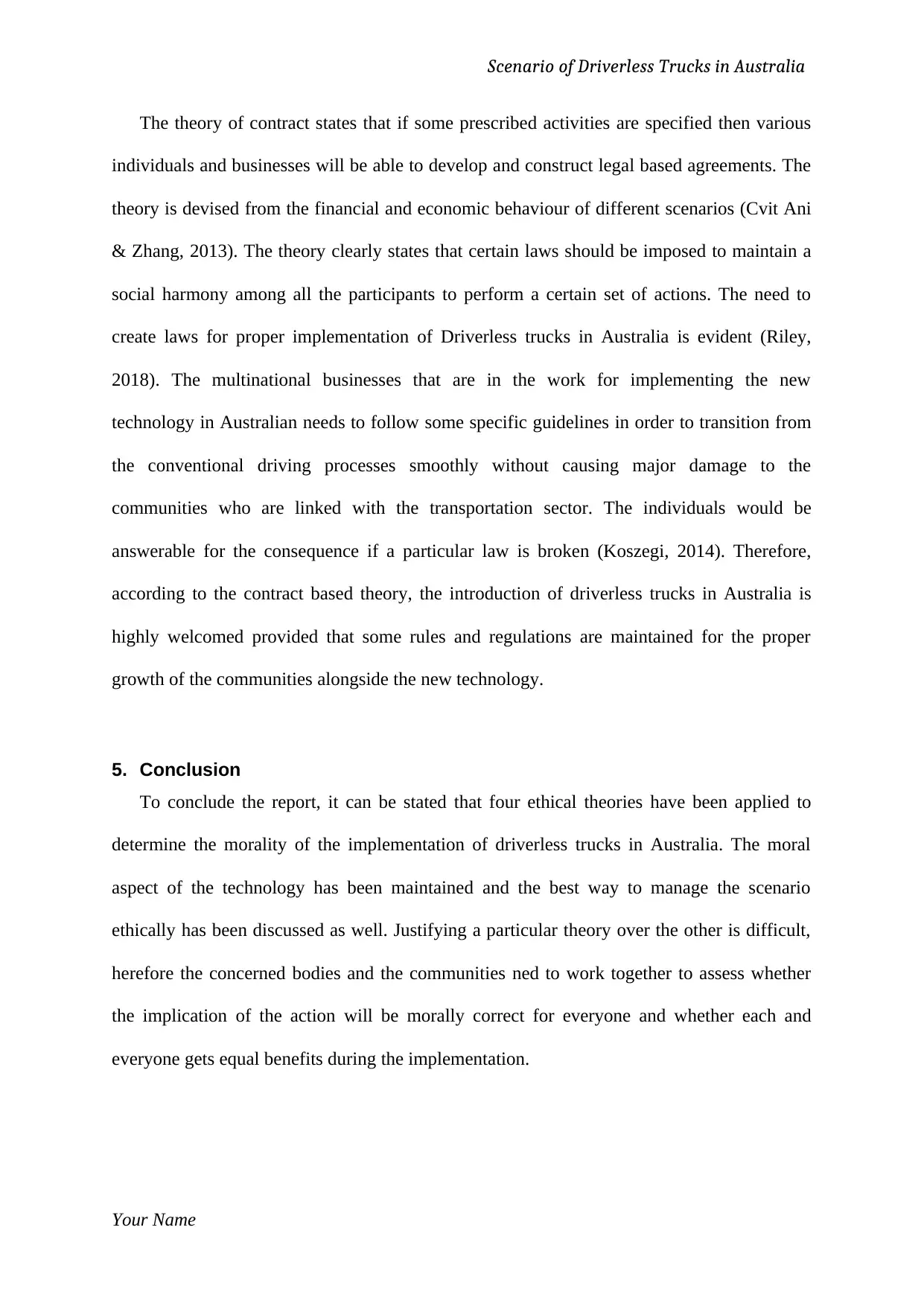
Scenario of Driverless Trucks in Australia
The theory of contract states that if some prescribed activities are specified then various
individuals and businesses will be able to develop and construct legal based agreements. The
theory is devised from the financial and economic behaviour of different scenarios (Cvit Ani
& Zhang, 2013). The theory clearly states that certain laws should be imposed to maintain a
social harmony among all the participants to perform a certain set of actions. The need to
create laws for proper implementation of Driverless trucks in Australia is evident (Riley,
2018). The multinational businesses that are in the work for implementing the new
technology in Australian needs to follow some specific guidelines in order to transition from
the conventional driving processes smoothly without causing major damage to the
communities who are linked with the transportation sector. The individuals would be
answerable for the consequence if a particular law is broken (Koszegi, 2014). Therefore,
according to the contract based theory, the introduction of driverless trucks in Australia is
highly welcomed provided that some rules and regulations are maintained for the proper
growth of the communities alongside the new technology.
5. Conclusion
To conclude the report, it can be stated that four ethical theories have been applied to
determine the morality of the implementation of driverless trucks in Australia. The moral
aspect of the technology has been maintained and the best way to manage the scenario
ethically has been discussed as well. Justifying a particular theory over the other is difficult,
herefore the concerned bodies and the communities ned to work together to assess whether
the implication of the action will be morally correct for everyone and whether each and
everyone gets equal benefits during the implementation.
Your Name
The theory of contract states that if some prescribed activities are specified then various
individuals and businesses will be able to develop and construct legal based agreements. The
theory is devised from the financial and economic behaviour of different scenarios (Cvit Ani
& Zhang, 2013). The theory clearly states that certain laws should be imposed to maintain a
social harmony among all the participants to perform a certain set of actions. The need to
create laws for proper implementation of Driverless trucks in Australia is evident (Riley,
2018). The multinational businesses that are in the work for implementing the new
technology in Australian needs to follow some specific guidelines in order to transition from
the conventional driving processes smoothly without causing major damage to the
communities who are linked with the transportation sector. The individuals would be
answerable for the consequence if a particular law is broken (Koszegi, 2014). Therefore,
according to the contract based theory, the introduction of driverless trucks in Australia is
highly welcomed provided that some rules and regulations are maintained for the proper
growth of the communities alongside the new technology.
5. Conclusion
To conclude the report, it can be stated that four ethical theories have been applied to
determine the morality of the implementation of driverless trucks in Australia. The moral
aspect of the technology has been maintained and the best way to manage the scenario
ethically has been discussed as well. Justifying a particular theory over the other is difficult,
herefore the concerned bodies and the communities ned to work together to assess whether
the implication of the action will be morally correct for everyone and whether each and
everyone gets equal benefits during the implementation.
Your Name
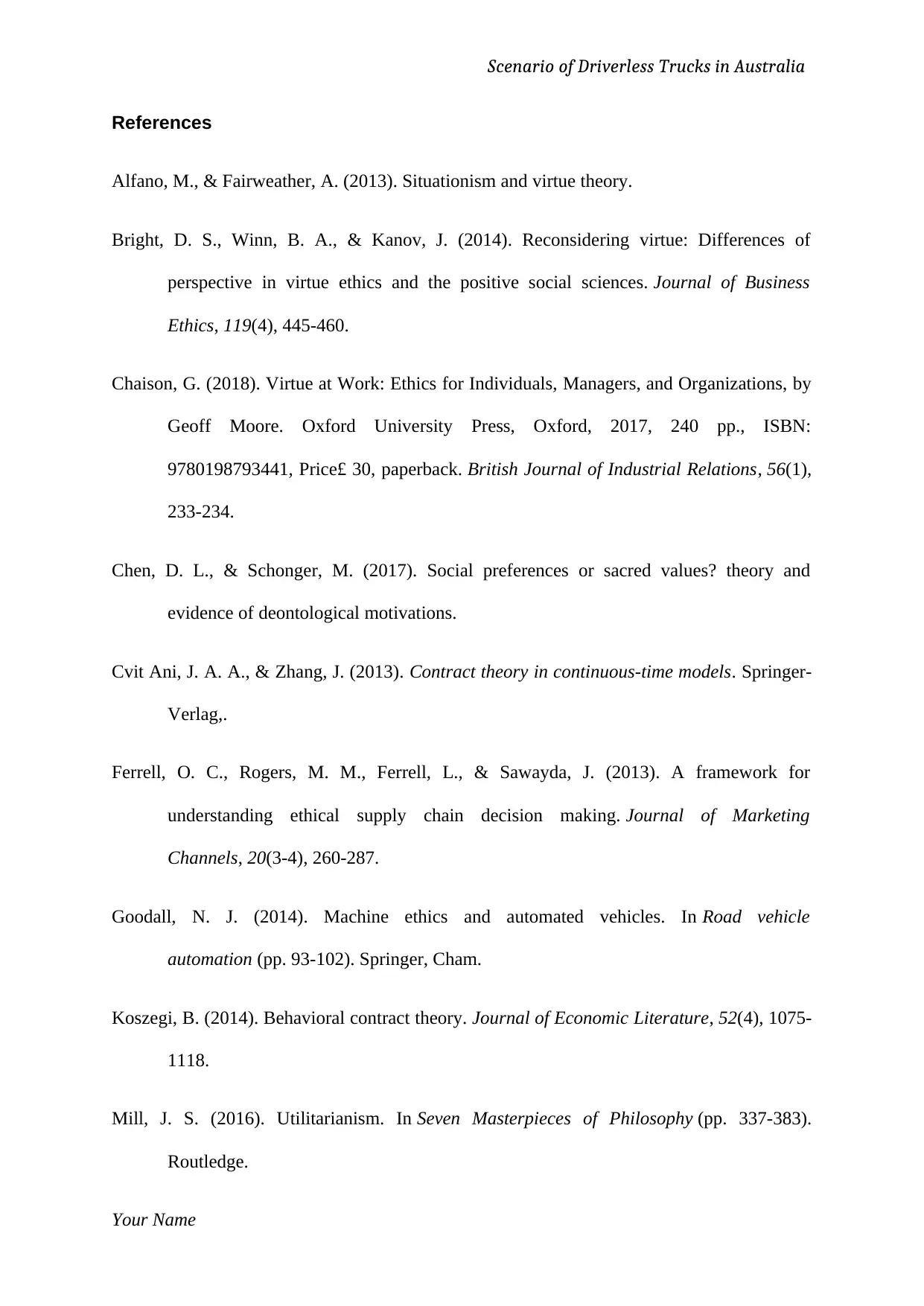
Scenario of Driverless Trucks in Australia
References
Alfano, M., & Fairweather, A. (2013). Situationism and virtue theory.
Bright, D. S., Winn, B. A., & Kanov, J. (2014). Reconsidering virtue: Differences of
perspective in virtue ethics and the positive social sciences. Journal of Business
Ethics, 119(4), 445-460.
Chaison, G. (2018). Virtue at Work: Ethics for Individuals, Managers, and Organizations, by
Geoff Moore. Oxford University Press, Oxford, 2017, 240 pp., ISBN:
9780198793441, Price£ 30, paperback. British Journal of Industrial Relations, 56(1),
233-234.
Chen, D. L., & Schonger, M. (2017). Social preferences or sacred values? theory and
evidence of deontological motivations.
Cvit Ani, J. A. A., & Zhang, J. (2013). Contract theory in continuous-time models. Springer-
Verlag,.
Ferrell, O. C., Rogers, M. M., Ferrell, L., & Sawayda, J. (2013). A framework for
understanding ethical supply chain decision making. Journal of Marketing
Channels, 20(3-4), 260-287.
Goodall, N. J. (2014). Machine ethics and automated vehicles. In Road vehicle
automation (pp. 93-102). Springer, Cham.
Koszegi, B. (2014). Behavioral contract theory. Journal of Economic Literature, 52(4), 1075-
1118.
Mill, J. S. (2016). Utilitarianism. In Seven Masterpieces of Philosophy (pp. 337-383).
Routledge.
Your Name
References
Alfano, M., & Fairweather, A. (2013). Situationism and virtue theory.
Bright, D. S., Winn, B. A., & Kanov, J. (2014). Reconsidering virtue: Differences of
perspective in virtue ethics and the positive social sciences. Journal of Business
Ethics, 119(4), 445-460.
Chaison, G. (2018). Virtue at Work: Ethics for Individuals, Managers, and Organizations, by
Geoff Moore. Oxford University Press, Oxford, 2017, 240 pp., ISBN:
9780198793441, Price£ 30, paperback. British Journal of Industrial Relations, 56(1),
233-234.
Chen, D. L., & Schonger, M. (2017). Social preferences or sacred values? theory and
evidence of deontological motivations.
Cvit Ani, J. A. A., & Zhang, J. (2013). Contract theory in continuous-time models. Springer-
Verlag,.
Ferrell, O. C., Rogers, M. M., Ferrell, L., & Sawayda, J. (2013). A framework for
understanding ethical supply chain decision making. Journal of Marketing
Channels, 20(3-4), 260-287.
Goodall, N. J. (2014). Machine ethics and automated vehicles. In Road vehicle
automation (pp. 93-102). Springer, Cham.
Koszegi, B. (2014). Behavioral contract theory. Journal of Economic Literature, 52(4), 1075-
1118.
Mill, J. S. (2016). Utilitarianism. In Seven Masterpieces of Philosophy (pp. 337-383).
Routledge.
Your Name
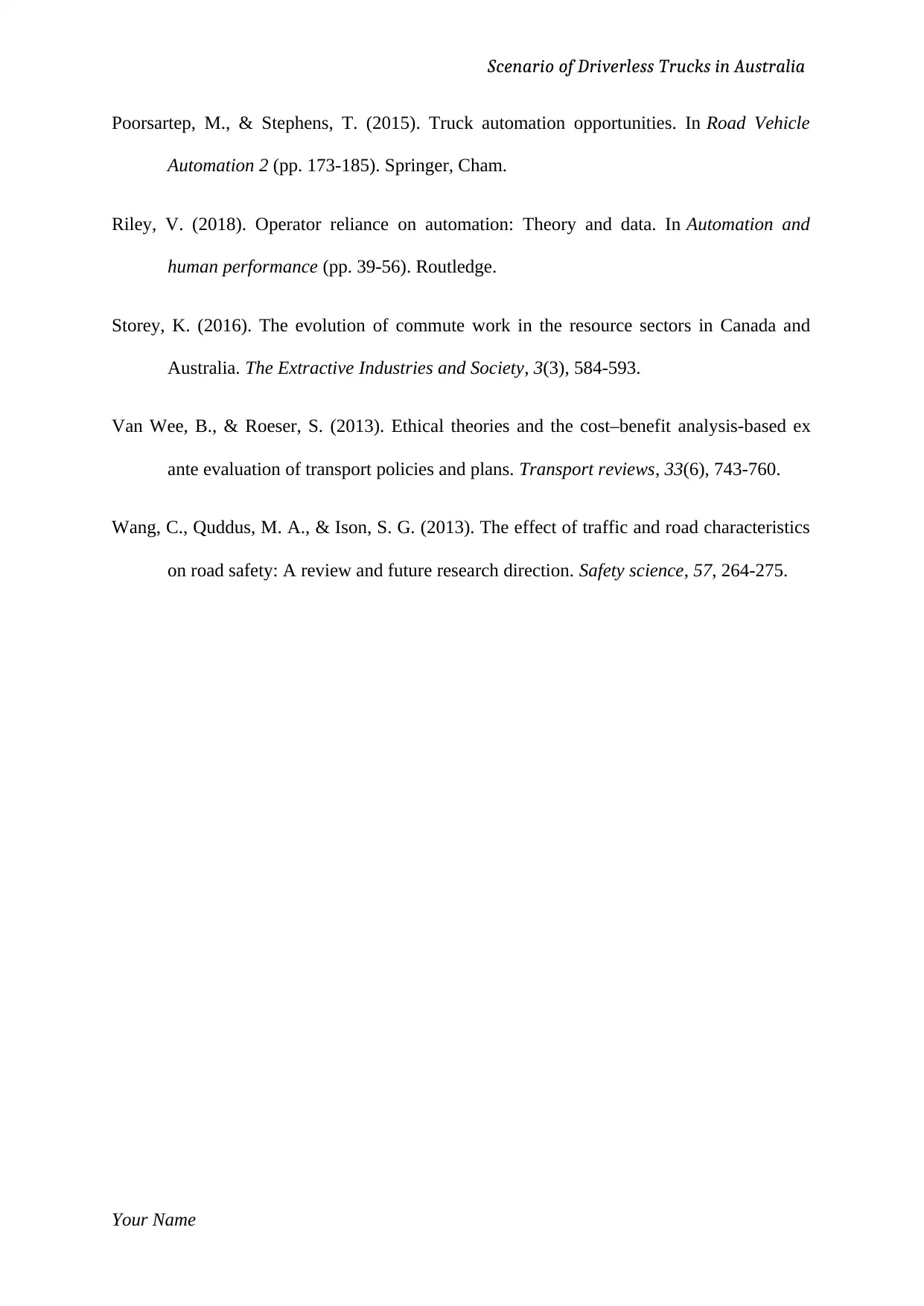
Scenario of Driverless Trucks in Australia
Poorsartep, M., & Stephens, T. (2015). Truck automation opportunities. In Road Vehicle
Automation 2 (pp. 173-185). Springer, Cham.
Riley, V. (2018). Operator reliance on automation: Theory and data. In Automation and
human performance (pp. 39-56). Routledge.
Storey, K. (2016). The evolution of commute work in the resource sectors in Canada and
Australia. The Extractive Industries and Society, 3(3), 584-593.
Van Wee, B., & Roeser, S. (2013). Ethical theories and the cost–benefit analysis-based ex
ante evaluation of transport policies and plans. Transport reviews, 33(6), 743-760.
Wang, C., Quddus, M. A., & Ison, S. G. (2013). The effect of traffic and road characteristics
on road safety: A review and future research direction. Safety science, 57, 264-275.
Your Name
Poorsartep, M., & Stephens, T. (2015). Truck automation opportunities. In Road Vehicle
Automation 2 (pp. 173-185). Springer, Cham.
Riley, V. (2018). Operator reliance on automation: Theory and data. In Automation and
human performance (pp. 39-56). Routledge.
Storey, K. (2016). The evolution of commute work in the resource sectors in Canada and
Australia. The Extractive Industries and Society, 3(3), 584-593.
Van Wee, B., & Roeser, S. (2013). Ethical theories and the cost–benefit analysis-based ex
ante evaluation of transport policies and plans. Transport reviews, 33(6), 743-760.
Wang, C., Quddus, M. A., & Ison, S. G. (2013). The effect of traffic and road characteristics
on road safety: A review and future research direction. Safety science, 57, 264-275.
Your Name
Paraphrase This Document
Need a fresh take? Get an instant paraphrase of this document with our AI Paraphraser
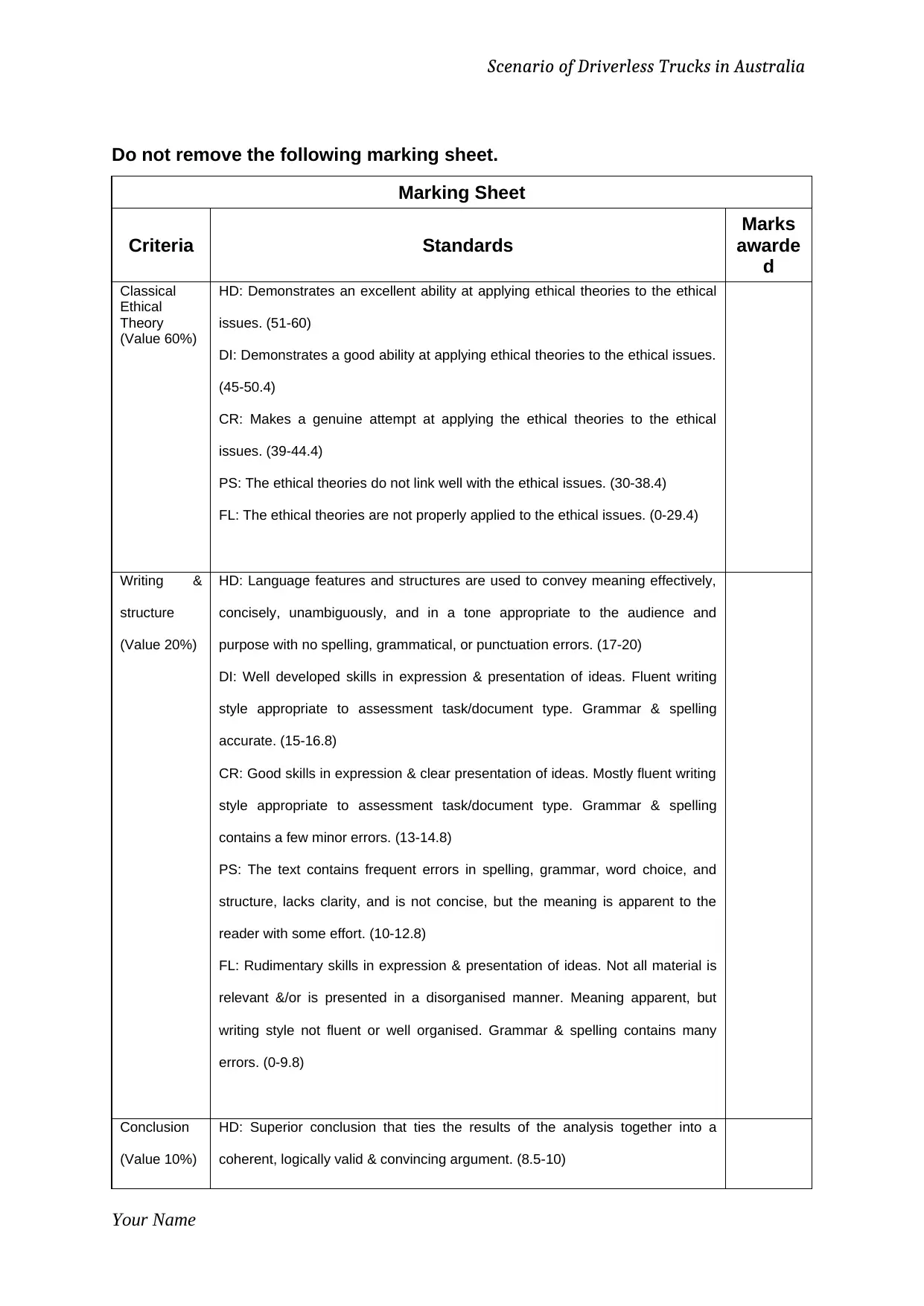
Scenario of Driverless Trucks in Australia
Do not remove the following marking sheet.
Marking Sheet
Criteria Standards
Marks
awarde
d
Classical
Ethical
Theory
(Value 60%)
HD: Demonstrates an excellent ability at applying ethical theories to the ethical
issues. (51-60)
DI: Demonstrates a good ability at applying ethical theories to the ethical issues.
(45-50.4)
CR: Makes a genuine attempt at applying the ethical theories to the ethical
issues. (39-44.4)
PS: The ethical theories do not link well with the ethical issues. (30-38.4)
FL: The ethical theories are not properly applied to the ethical issues. (0-29.4)
Writing &
structure
(Value 20%)
HD: Language features and structures are used to convey meaning effectively,
concisely, unambiguously, and in a tone appropriate to the audience and
purpose with no spelling, grammatical, or punctuation errors. (17-20)
DI: Well developed skills in expression & presentation of ideas. Fluent writing
style appropriate to assessment task/document type. Grammar & spelling
accurate. (15-16.8)
CR: Good skills in expression & clear presentation of ideas. Mostly fluent writing
style appropriate to assessment task/document type. Grammar & spelling
contains a few minor errors. (13-14.8)
PS: The text contains frequent errors in spelling, grammar, word choice, and
structure, lacks clarity, and is not concise, but the meaning is apparent to the
reader with some effort. (10-12.8)
FL: Rudimentary skills in expression & presentation of ideas. Not all material is
relevant &/or is presented in a disorganised manner. Meaning apparent, but
writing style not fluent or well organised. Grammar & spelling contains many
errors. (0-9.8)
Conclusion
(Value 10%)
HD: Superior conclusion that ties the results of the analysis together into a
coherent, logically valid & convincing argument. (8.5-10)
Your Name
Do not remove the following marking sheet.
Marking Sheet
Criteria Standards
Marks
awarde
d
Classical
Ethical
Theory
(Value 60%)
HD: Demonstrates an excellent ability at applying ethical theories to the ethical
issues. (51-60)
DI: Demonstrates a good ability at applying ethical theories to the ethical issues.
(45-50.4)
CR: Makes a genuine attempt at applying the ethical theories to the ethical
issues. (39-44.4)
PS: The ethical theories do not link well with the ethical issues. (30-38.4)
FL: The ethical theories are not properly applied to the ethical issues. (0-29.4)
Writing &
structure
(Value 20%)
HD: Language features and structures are used to convey meaning effectively,
concisely, unambiguously, and in a tone appropriate to the audience and
purpose with no spelling, grammatical, or punctuation errors. (17-20)
DI: Well developed skills in expression & presentation of ideas. Fluent writing
style appropriate to assessment task/document type. Grammar & spelling
accurate. (15-16.8)
CR: Good skills in expression & clear presentation of ideas. Mostly fluent writing
style appropriate to assessment task/document type. Grammar & spelling
contains a few minor errors. (13-14.8)
PS: The text contains frequent errors in spelling, grammar, word choice, and
structure, lacks clarity, and is not concise, but the meaning is apparent to the
reader with some effort. (10-12.8)
FL: Rudimentary skills in expression & presentation of ideas. Not all material is
relevant &/or is presented in a disorganised manner. Meaning apparent, but
writing style not fluent or well organised. Grammar & spelling contains many
errors. (0-9.8)
Conclusion
(Value 10%)
HD: Superior conclusion that ties the results of the analysis together into a
coherent, logically valid & convincing argument. (8.5-10)
Your Name
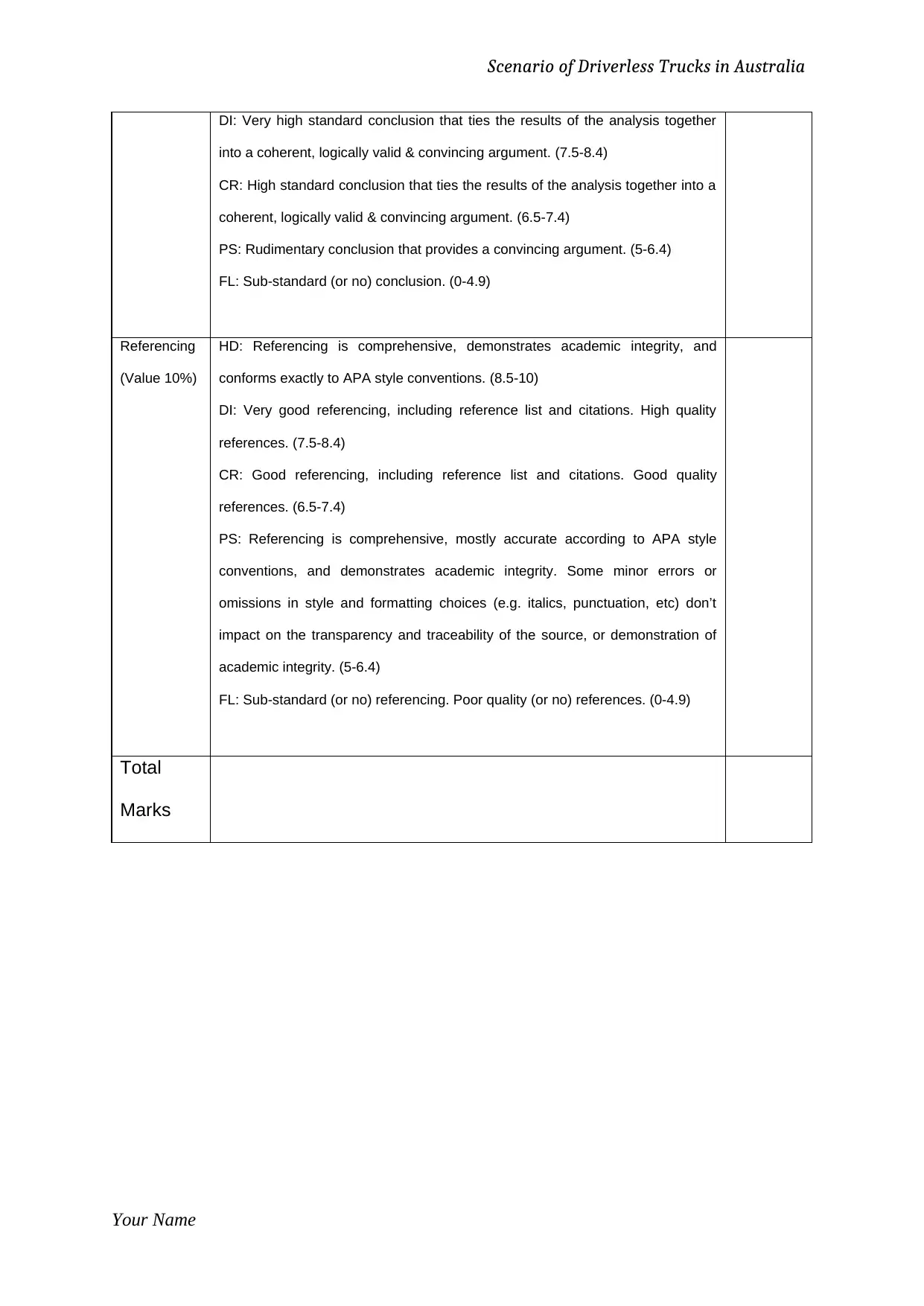
Scenario of Driverless Trucks in Australia
DI: Very high standard conclusion that ties the results of the analysis together
into a coherent, logically valid & convincing argument. (7.5-8.4)
CR: High standard conclusion that ties the results of the analysis together into a
coherent, logically valid & convincing argument. (6.5-7.4)
PS: Rudimentary conclusion that provides a convincing argument. (5-6.4)
FL: Sub-standard (or no) conclusion. (0-4.9)
Referencing
(Value 10%)
HD: Referencing is comprehensive, demonstrates academic integrity, and
conforms exactly to APA style conventions. (8.5-10)
DI: Very good referencing, including reference list and citations. High quality
references. (7.5-8.4)
CR: Good referencing, including reference list and citations. Good quality
references. (6.5-7.4)
PS: Referencing is comprehensive, mostly accurate according to APA style
conventions, and demonstrates academic integrity. Some minor errors or
omissions in style and formatting choices (e.g. italics, punctuation, etc) don’t
impact on the transparency and traceability of the source, or demonstration of
academic integrity. (5-6.4)
FL: Sub-standard (or no) referencing. Poor quality (or no) references. (0-4.9)
Total
Marks
Your Name
DI: Very high standard conclusion that ties the results of the analysis together
into a coherent, logically valid & convincing argument. (7.5-8.4)
CR: High standard conclusion that ties the results of the analysis together into a
coherent, logically valid & convincing argument. (6.5-7.4)
PS: Rudimentary conclusion that provides a convincing argument. (5-6.4)
FL: Sub-standard (or no) conclusion. (0-4.9)
Referencing
(Value 10%)
HD: Referencing is comprehensive, demonstrates academic integrity, and
conforms exactly to APA style conventions. (8.5-10)
DI: Very good referencing, including reference list and citations. High quality
references. (7.5-8.4)
CR: Good referencing, including reference list and citations. Good quality
references. (6.5-7.4)
PS: Referencing is comprehensive, mostly accurate according to APA style
conventions, and demonstrates academic integrity. Some minor errors or
omissions in style and formatting choices (e.g. italics, punctuation, etc) don’t
impact on the transparency and traceability of the source, or demonstration of
academic integrity. (5-6.4)
FL: Sub-standard (or no) referencing. Poor quality (or no) references. (0-4.9)
Total
Marks
Your Name
1 out of 9
Related Documents
Your All-in-One AI-Powered Toolkit for Academic Success.
+13062052269
info@desklib.com
Available 24*7 on WhatsApp / Email
![[object Object]](/_next/static/media/star-bottom.7253800d.svg)
Unlock your academic potential
© 2024 | Zucol Services PVT LTD | All rights reserved.





